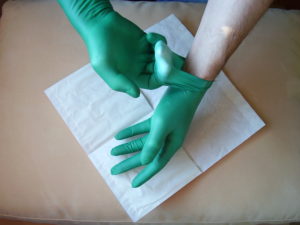Occupational Risk Factors Among Nursing Professionals
Background
 Health care and social assistance makes up 12.4% of the Ontario workforce [1]. In 2019, there were over 160,000 nurses working in Ontario [2]. Nurses treat people who are sick, injured, or infirm, and support the delivery of around-the-clock care for patients. They also provide health services to the public.
Health care and social assistance makes up 12.4% of the Ontario workforce [1]. In 2019, there were over 160,000 nurses working in Ontario [2]. Nurses treat people who are sick, injured, or infirm, and support the delivery of around-the-clock care for patients. They also provide health services to the public.
The Occupational Disease Surveillance System (ODSS) follows 36,400 nurses in the health care sector:
-
- 79% work in Hospitals
- 6% work in Related Health Care Institutions such as nursing and long-term care homes
- 6% work in Welfare Services such as boarding houses for the aged, day nurseries, and shelters
- 5% work in Miscellaneous Health Services such as voluntary health associations primarily engaged in promoting health and health services
- 4% work in Diagnostic and Therapeutic Services such as medical, dental or x-ray laboratories providing analysis, diagnosis or treatment services
- 1% work in Offices of Physicians and Surgeons or Offices of Para-Medical Personnel (Practitioners)
Note: Percentages do not total to 100% as nurses may have worked in more than one sector
Occupational exposures
Nurses work in a variety of settings and circumstances that result in different occupational exposures. Potential occupational exposures include night shift work, ionizing radiation, antineoplastic (anti-cancer or chemotherapy) drugs, and wet work. These occupational exposures are highlighted here based on their link to disease outcomes currently monitored in the ODSS. Other occupational exposures in nursing that are not addressed in this alert include infectious diseases and traumatic stress, among others.
Night shift work
Night shift work impacts approximately 18% of workers in health care and social assistance [3]. It is classified as a probable cause of breast cancer by the International Agency for Research on Cancer [4]. Working night or rotating shifts can also lead to poorer quality of sleep, increased stress, lifestyle disturbances, reduced sun exposure and disruptions to the body’s circadian rhythm [5]. Scheduled nursing shifts typically range from about 8-12 hours, and approximately 25% of nurses report working overtime hours [6].
Ionizing radiation
Nurses may be exposed to low-dose ionizing radiation such as x-rays when assisting patients during diagnostic imaging procedures, or caring for patients undergoing treatments involving radioactive substances (i.e. brachytherapy or therapeutic nuclear medicine) [7,8]. Ionizing radiation is a known risk for cancer development [9] and some studies have linked long-term exposure to low doses of ionizing radiation with an increased risk of some cancers, though the evidence is inconsistent [10-13].
Antineoplastic drugs
Preparing and administering antineoplastic drugs can lead to occupational exposure for workers through dermal contact (touching a contaminated surface), ingestion (via hand-to-mouth contact), inhalation (of aerosols from liquid medications or dusts from crushed tablets), and possibly through accidental injection from sharps and needles [14, 15]. Health risks resulting from occupational exposures to antineoplastic drugs include cancer and adverse reproductive outcomes (i.e. stillbirth, low birthweight, congenital anomalies) [16-18].
Wet work

Wet work involves extensive hand washing (more than 20 times per shift), immersing hands in water for more than 2 hours per shift, or wearing gloves for extended periods. Wet work has been identified as a main risk factor for hand dermatitis which can cause hands to be itchy or painful. It may occur for a short period (acute) or be a long-lasting (chronic) condition.
Occupational Disease Risks
Elevated risk of breast cancer, melanoma, thyroid cancer, myeloma, non-Hodgkin lymphoma, asthma, and carpal tunnel syndrome were observed among nurses compared to other occupations in the ODSS. Contact dermatitis is also an occupational disease risk common in nurses although this relationship was not observed in the ODSS.
Breast cancer
| Sub-sector or occupation | Increased risk |
| Female nurses, overall | 20%* |
| In hospitals | 22%* |
| In diagnostic and therapeutic services | 40%* |
| In offices of physicians and surgeons | 85% |
| Males working in nursing, therapy and related assisting occupations | 351% |
| *Statistically significant (α=0.05) | |
Breast cancer among women is often attributed to reproductive, genetic, and hormonal factors such as family history, reproductive history, and use of oral contraception. Detecting increased risk of breast cancer in both male and female nurses is consistent with the hypothesis that work-related risk factors such as night shift work may be a contributing factor.
Excess risk observed among nursing professionals working in diagnostic and therapeutic services may be related to their exposure to ionizing radiation.
Melanoma
| Sub-sector or occupation | Increased risk |
| Nurses, overall | 53%* |
| In hospitals | 44%* |
| In related health care institutions | 54% |
| In diagnostic and therapeutic services | 92%* |
| In miscellaneous health services | 219%* |
| In welfare organizations | 54% |
| *Statistically significant (α=0.05) | |
Nursing professionals employed across institution types had consistently increased risks of melanoma. Previous studies have similarly observed higher risk for melanoma among nurses although the relationship is not well understood [19-21].
Thyroid Cancer
| Sub-sector or occupation | Increased risk |
| Nurses, overall | 23%* |
| In hospitals | 23%* |
| In related health care institutions | 32% |
| In diagnostic and therapeutic services | 23% |
| In miscellaneous health services | 17%* |
| *Statistically significant (α=0.05) | |
The thyroid is one of the body’s most sensitive organs to ionizing radiation and studies have shown that occupational exposures to low doses of ionizing radiation have an effect on thyroid function [22].
Myeloma
| Sub-sector or occupation | Increased risk |
| Nurses, overall | 26% |
| In hospitals | 29% |
| In diagnostic and therapeutic services | 295%* |
| *Statistically significant (α=0.05) | |
Previous research has found increased risks of myeloma among health care workers and suggests that the higher risks may be attributed to exposure to viral and bacterial infections [23,24]. Working in diagnostic and therapeutic services may lead to higher levels of exposures to infectious patients or infectious substances in patient bio-samples.
Non-Hodgkin lymphoma (NHL)
| Sub-sector or occupation | Increased risk |
| Nurses, overall | — |
| In hospitals | 23% |
| NHL results were not statistically significant. | |
Occupational risk factors for NHL are not well understood. Some previous studies have found an increased risk of NHL among patients exposed to ionizing radiation from medical imaging, as well as among people infected with certain viral pathogens. While occupational exposure has not been directly linked to increased risk, these may be possible NHL risk factors for nurses [25].
Asthma
| Sub-sector or occupation | Increased risk |
| Nurses, overall | — |
| In related health care institutions | 56%* |
| In diagnostic and therapeutic services | 165%* |
| *Statistically significant (α=0.05) | |
Previous studies have observed increased risk of asthma among health care workers and have attributed this to the use of cleaning products and administration of aerosolized medications [26-28].
Carpal tunnel syndrome
| Sub-sector or occupation | Increased risk |
| Nurses, overall | — |
| In related health care institutions | 17% |
| In welfare organizations | 40%* |
| *Statistically significant (α=0.05) | |
Repetitive or forceful hand and wrist movements may put nurses at risk of developing carpal tunnel syndrome. Pushing down the plunger in syringes, pressing blood pressure bulbs, or manually lifting or moving a patient are some of the repetitive movements that nurses may encounter.
Contact dermatitis
Nursing professionals are generally considered high risk for dermatitis due to exposure to wet work through hand hygiene and extensive glove use. Studies have reported that contact dermatitis among health care workers remains high even with the promotion of preventative measures such as developing best practice guidelines for glove use, using hand moisturizing products, and using hand alcohol with emollients (moisturizer) instead of soap and water as a disinfectant when appropriate [29,30].
This association was not observed among nurses in the ODSS. A possible explanation may be that nurses may be more likely than other workers to self-manage their skin condition, so no physician diagnosis is captured in the data sources establishing the ODSS [31].
Resources:
Free e-learning module on work-related contact dermatitis offered by Public Services Health & Safety Association.
Occupation and industry descriptions
1. Nurses: occupations concerned with assisting physicians and giving nursing care to the sick or injured. This definition includes Nurse Practitioners, Registered Nurses, Registered Psychiatric Nurses, and Licensed Practical Nurses. This does not include nursing supervisors.
2. Diagnostic and Therapeutic services: Establishments primarily engaged in rendering diagnostic and therapeutic services not elsewhere specified. This includes laboratories (dental, medical, x-ray, etc.), providing professional analysis, diagnosis, or treatment services, or organizations such as the Red Cross Blood Transfusion Service, and St. John Ambulance.
3. Nursing, Therapy, and Related Assisting Occupations: encompasses occupations concerned with giving nursing care to the sick and other related assisting occupations such as nursing supervisors, graduate nurses, registered nursing assistants, physiotherapist, occupational therapists, nursing aides and orderlies, and other related assisting occupations not elsewhere classified.
4. Related Health Care Institutions: Establishments such as nursing homes and infirmaries primarily engaged in providing nursing care and accommodations for inpatients.
5. Miscellaneous Health Services: Establishments commonly referred to as voluntary health associations primarily engaged in promoting health and health services other than diagnostic or therapeutic services. This includes places such as Canadian Hospital Association, Canadian Public Health Association, National Cancer Institute.
6. Welfare Organizations: Establishments primarily engaged in providing basic home care (no treatments or nursing care), such as homes for the aged, blind or senile, boarding houses for the aged, day nurseries, or shelters.
Risk Reduction Strategies
It is important to identify and understand workplace hazards to be able to properly control them. The recognizing, assessing, controlling, and evaluating (RACE) process is designed to help identify and address workplace hazards. More information on this process can be found on Ministry of Labour, Training and Skills Development’s Supervisor Health and Safety Awareness in 5 steps document here .

Implementing comprehensive exposure reduction policies and practices at the system and institutional level that include, wherever possible, elimination, substitution, and engineering controls in addition to administrative practices can reduce occupational exposures for workers. Employers should also continue providing workers with education and training in reducing the risk of occupational exposures.
Night shift work
For nurses working in institutions providing around the clock care, night shift work may be unavoidable. However, some of the adverse health effects of shift work may be reduced through modifications to shift scheduling practices [32,33]. Risk reduction strategies presented by the Institute of Work and Health and the Workers Health & Safety Centre include, where possible:
-
- Avoiding permanent night work
- Using forward-rotating (morning to evening to night) shift schedules
- Limiting the number of consecutive night shifts
- Increasing the speed of shift rotations
- Providing adequate resting time (>11 hours) between shifts
- Limiting weekend work
- Allowing self-scheduling to give individuals some control over their work and rest days
Ionizing radiation
Exposure to ionizing radiation should be kept as low as reasonably achievable. This is accomplished by reducing the time spent in areas with radiation exposure, increasing the distance between the worker and radiation source, and properly using shielding barriers such as a lead apron or concrete walls. Wearing personal dosimeters when at work helps measure radiation exposure and can help prevent overexposure.
There are both federal and provincial regulations governing the use of ionizing radiation in healthcare settings to reduce the risk of ionizing radiation to workers. This includes ensuring adequate shielding is used in the design of workspaces, use of warning indicators, and ensuring regular testing of equipment. More information on government regulations can be found below:
Antineoplastic drugs
Ensuring institutions have policies and procedures in place outlining the safe handling of antineoplastic drugs can help reduce the risk of worker exposure. All potentially exposed workers should have access to safety protocols and have routine training on the safety procedures to prevent mishandling. This includes workers at all stages of antineoplastic drug handling, from shipping and storage to disposal.
Implementing engineering controls such as biological safety cabinets, using separate equipment when handling or dispensing antineoplastic drugs, or closed system transfer devices can also minimize occupational exposure.
Resources:
The Public Services Health and Safety Association:
- The Antineoplastic Drug Risk Assessment in Community Settings Manual provides a guide and assessment tool aims to help workplaces identify and reduce their exposure to antineoplastic drugs
- Free e-learning module available on antineoplastic drugs. This module was developed through the Ministry of Labour, Training and Skills Development funding with Dr. Chun- Yin Hop
Occupational Cancer Research Centre:
Screening
Following proper cancer screening guidelines can help identify and treat cancers earlier, and lead to better treatment outcomes.
Breast cancer screening:
The Ontario Breast Screening Program encourages most women between the ages of 50-74 to get screened using mammography every 2 years. To learn more about the Ontario Breast Screening Program, visit the Cancer Care Ontario website here.
Skin cancer screening:
Ontario does not have a routine skin cancer screening program. Those at higher risk of skin cancer are advised to see their health care provider or dermatologist to discuss their risk and any routine screening recommendations. Examples of factors that may increase the risk of skin cancer include a family history of melanoma, a personal history of skin cancer (basal or squamous cell carcinoma), or use of medications that weaken the body’s immune response (i.e. immunosuppressive medication after an organ transplant) or make the skin more sensitive to the sun.
The Canadian Dermatology Association has outlined steps for individuals to complete a self-skin examination at home with what to look for during the examination
References
1. Statistics Canada. Labour force characteristics by industry (Updated 2021)
2. Canadian Institute for Health Information. Nursing in Canada, 2019 (2020)
3. CAREX Canada. Night shift work occupational exposures.
4. International Agency for Research on Cancer (IARC). Night shift work. IARC Monographs on the Evaluation of Carcinogenic Risks to Humans Vol. 124 (2020).
5. Fritschi L, Glass DC, Heyworth JS, et al. Hypotheses for mechanisms linking shiftwork and cancer. Med Hypotheses. 2011;77(3):430–6.
6. Statistics Canada. Overtime work among professional nurses during the COVID-19 pandemic (2020)
7. Stokowski LA. The risky business of nursing. Medscape (2014)
8. Russell J, Burbridge BE, Duncan MD, Tynan J. Adult fingers visualized on neonatal intensive care unit chest radiographs: what you don’t see. Canadian Association of Radiologists Journal. 2013 Aug;64(3):236-9.
9. International Agency for Research on Cancer (IARC). Radiation. IARC Monographs on the Evaluation of Carcinogenic Risks to Humans Vol. 100D (2012).
10. Hauptmann M, Daniels RD, Cardis E, Cullings HM, Kendall G, Laurier D, Linet MS, Little MP, Lubin JH, Preston DL, Richardson DB. Epidemiological studies of low-dose ionizing radiation and cancer: summary bias assessment and meta-analysis. JNCI Monographs. 2020 Jul 1;2020(56):188-200.
11. Sont WN, Zielinski JM, Ashmore JP, Jiang H, Krewski D, Fair ME, Band PR, Letourneau EG. First analysis of cancer incidence and occupational radiation exposure based on the National Dose Registry of Canada. American journal of epidemiology. 2001 Feb 15;153(4):309-18.
12. Zielinski JM, Garner MJ, Band PR, Krewski D, Shilnikova NS, Jiang H, Ashmore PJ, Sont WN, Fair ME, Letourneau EG, Semenciw R. Health outcomes of low-dose ionizing radiation exposure among medical workers: a cohort study of the Canadian national dose registry of radiation workers. International journal of occupational medicine and environmental health. 2009 Apr 1;22(2):149.
13. Descatha A, Jenabian A, Conso F, Ameille J. Occupational exposures and haematological malignancies: overview on human recent data. Cancer Causes & Control. 2005 Oct;16(8):939-53.
14. Connor TH, McDiarmid MA. Preventing occupational exposures to antineoplastic drugs in health care settings. CA: A cancer journal for clinicians. 2006 Nov;56(6):354-65.
15. Hon CY, Teschke K, Shen H, Demers PA, Venners S. Antineoplastic drug contamination in the urine of Canadian healthcare workers. International archives of occupational and environmental health. 2015 Oct;88(7):933-41.
16. International Agency for Research on Cancer (IARC). Pharmaceuticals. IARC Monographs on the Evaluation of Carcinogenic Risks to Humans Vol. 100A (2012).
17. Dranitsaris G, Johnston M, Poirier S, Schueller T, Milliken D, Green E, Zanke B. Are health care providers who work with cancer drugs at an increased risk for toxic events? A systematic review and meta-analysis of the literature. Journal of oncology pharmacy practice. 2005 Jun;11(2):69-78.
18. Ratner PA, Spinelli JJ, Beking K, Lorenzi M, Chow Y, Teschke K, Le ND, Gallagher RP, Dimich-Ward H. Cancer incidence and adverse pregnancy outcome in registered nurses potentially exposed to antineoplastic drugs. BMC nursing. 2010 Dec;9(1):1-1.
19. Lie JA, Andersen A, Kjærheim K. Cancer risk among 43 000 Norwegian nurses. Scandinavian journal of work, environment & health. 2007 Feb 1:66-73.
20. Parent MÉ, El-Zein M, Rousseau MC, Pintos J, Siemiatycki J. Night work and the risk of cancer among men. American journal of epidemiology. 2012 Nov 1;176(9):751-9.
21. Fortes C, De Vries E. Nonsolar occupational risk factors for cutaneous melanoma. International journal of dermatology. 2008;47(4):319-28.
22. Cioffi DL, Fontana L, Leso V, Dolce P, Vitale R, Vetrani I, Galdi A, Iavicoli I. Low dose ionizing radiation exposure and risk of thyroid functional alterations in healthcare workers. European Journal of Radiology. 2020 Nov 1;132:109279
23. Andreotti G, Katz M, Hoering A, Van Ness B, Crowley J, Morgan G, Hoover RN, Baris D, Durie B. Risk of multiple myeloma in a case–spouse study. Leukemia & lymphoma. 2016 Jun 2;57(6):1450-9.
24. Gold LS, Milliken K, Stewart P, Purdue M, Severson R, Seixas N, Blair A, Davis S, Hartge P, De Roos AJ. Occupation and multiple myeloma: an occupation and industry analysis. American journal of industrial medicine. 2010 Aug;53(8):768-79.
25. Hartge P, Smith MT. Environmental and behavioral factors and the risk of non-Hodgkin lymphoma. Cancer Epidemiology and Prevention Biomarkers. 2007 Mar 1;16(3):367-8.
26. Delclos GL, Gimeno D, Arif AA, Burau KD, Carson A, Lusk C, Stock T, Symanski E, Whitehead LW, Zock JP, Benavides FG. Occupational risk factors and asthma among health care professionals. American Journal of Respiratory and Critical Care Medicine. 2007 Apr 1;175(7):667-75.
27. Caridi MN, Humann MJ, Liang X, Su FC, Stefaniak AB, LeBouf RF, Stanton ML, Virji MA, Henneberger PK. Occupation and task as risk factors for asthma-related outcomes among healthcare workers in New York City. International journal of hygiene and environmental health. 2019 Mar 1;222(2):211-20.
28. Mirabelli MC, Zock JP, Plana E, Antó JM, Benke G, Blanc PD, Dahlman-Höglund A, Jarvis DL, Kromhout H, Lillienberg L, Norbäck D. Occupational risk factors for asthma among nurses and related healthcare professionals in an international study. Occupational and Environmental Medicine. 2007 Jul 1;64(7):474-9.
29. Nichol K, Copes R, Kersey K, Eriksson J, Holness DL. Screening for hand dermatitis in healthcare workers: comparing workplace screening with dermatologist photo screening. Contact dermatitis. 2019 Jun;80(6):374-81.
30. Ontario Agency for Health Protection and Promotion (Public Health Ontario). Recommendations for the prevention, detection and management of occupational dermatitis in health care settings. Toronto, ON: Queen’s Printer for Ontario; 2019.
31. Shakik S, Arrandale V, Holness DL, MacLeod JS, McLeod CB, Peter A, Demers PA. Dermatitis among workers in Ontario: results from the Occupational Disease Surveillance System. Occupational and environmental medicine. 2019;76(9):625-31.
32. Institute for Work and Health. Shift work and health. (2010)
33. Workers Health and Safety Centre. Shift work: Disrupting worker health and lives.
Surveillance Bulletins
The Occupational Disease Surveillance System (ODSS) Surveillance Bulletins provide summaries of occupational exposures and disease risks across different industries and occupational groups. The aim of these bulletins is to report on high risk occupations and industries and specific exposures detected through occupational disease surveillance. At this time the ODSS includes workers from 1983-2014 and follows their health outcomes until 2016. This bulletin reflects only the diseases currently tracked within the ODSS. The system is updated and expanded on an ongoing basis.
More information about the ODSS including data sources, methods and detailed results can be found at ODSP-OCRC.ca and OccDiseaseStats.ca.
